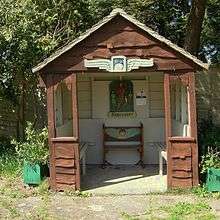The Sanctuary (community)
The Sanctuary, near Storrington in West Sussex, England, was a utopian community which was founded in 1923 and lasted about a decade.

Founding and concept
The founder and central figure of The Sanctuary community was Vera Pragnell (1897-1968), the daughter of a textile manufacturer. Using her inheritance, she purchased 50 acres of land at Heath Common and proceeded to give away plots of land free of charge to anyone who was willing to settle there. She lived in a house she named Sanctuary Cottage, part of which was kept open for any passing stranger who needed shelter or refreshment...[1]
Vera Pragnell was inspired both by Christianity (in particular William E. Orchard and the Fellowship of Reconciliation)[2] as well as the principles of pioneering socialist Edward Carpenter.[1] She imposed no conditions or rules on prospective settlers and insisted that The Sanctuary was open to everyone. Initially, all who came to live there were given a half-acre plot on which they would park a caravan or build a simple house. Eventually communal facilities were created such as a shop, a school and a building used for theatre and dancing.
Lacking a single political or spiritual focus, The Sanctuary attracted a wide range of individuals as residents or visitors, often with unorthodox and radical views. These included pagans such as the occultist, poet and publisher Victor Neuburg[3] and Dion Byngham, ex-leading light of the Order of Woodcraft Chivalry.[4] Other residents included anarchist W. C. Owen [5] as well as Communist Party members.[2] Artists were also attracted to the community, such as the landscape artist William Heaton Cooper [6] and the Shakespearean actor Wilfred Walter.[7]
A number of the residents and visitors were friends and associates of Edward Carpenter, who was a supporter and inspiration to the community.[8] In 1928, Vera Pragnell published her book "The Story of the Sanctuary" [1] and dedicated it to the "splendid pioneer" Edward Carpenter with a poem by Victor Neuburg praising Carpenter as "our Youth's doyen". Vera had a personal connection with Carpenter, as in 1927 she had married the painter Dennis Earle[9], who had previously been known as Ted Earle when he was Carpenter's lover [8]
Decline
The unconventional lifestyles of some members of the community began to generate scandal in the popular press, with stories featuring nudism and 'free love' and allegations that they encouraged a girl to run away from home and live at the Sanctuary[10]
By the early 1930s, Vera Pragnell's original inspiration had been lost amid disputes and disillusionment[11]. Sanctuary residents began to register formal ownership of their own properties and from 1934 onwards the area was developed by Earle as a residential estate known as Longbury Hill.[2]
During World War II, the Kenyan independence leader Jomo Kenyatta lived in the area whilst working on a local farm. Communist Party youth camps continued to be held there until the 1960s.[2]
Legacy
Today, the history of the area is remembered in the street names Vera's Walk and Sanctuary Lane and the houses known as Sanctuary Cottages. A memorial shelter remains, erected and decorated by Dennis Earle, containing boards telling the story of The Sanctuary.
The area known as The Sanctuary was located in the parish of Washington, West Sussex (not Storrington). Vera Pragnell and Dennis Earle are buried in the graveyard at Washington Parish Church.
A play entitled Sanctuary, featuring Vera Pragnell and Victor Neuburg, written by Chris Green, was presented at the 2012 Brighton Fringe Festival.
References
- Pragnell, Vera (1928). The Story of the Sanctuary. Steyning: The Vine Press.
- Hare, Chris (2000). The Washington Story. Washington Parish Council. ISBN 0-9538217-0-6.
- Overton-Fuller, Jean (2005). The Magical Dilemma of Victor Neuburg. Mandrake. ISBN 1869928792.
- Hutton, Ronald (1999). The Triumph of the Moon: A History of Modern Pagan Witchcraft. Oxford University Press. ISBN 9780192854490.
- Coates, Chris (2001). Utopia Britannica: British Utopian Experiments 1325-1945. Diggers & Dreamers. ISBN 9780951494585.
- "Miss Vera Pragnell Marriage". Worthing Herald (newspaper). 16 July 1927.
- "Storrington & District Museum Newsletter 41. Spring 2012" (PDF).
- Rowbotham, Sheila (2008). Edward Carpenter: A Life of Liberty and Love. Verso. ISBN 978-1-84467-295-0.
- "Miss Vera Pragnell Marriage". Worthing Herald (newspaper). 16 July 1927.
- "Young girl wrecked by crooked moral cranks". John Bull (newspaper). 2 March 1929.
- "The Sanctuary's Collapse". Worthing Herald (newspaper). 24 October 1931.